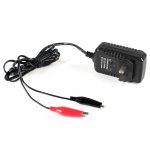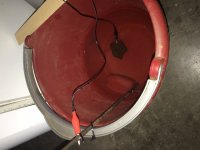Ok I'm sure it's been posted on here already, but I'm sitting here searching and can't seem to find what I'm looking for directly. I have my chargers I plan to use coming in today and would like to get some stuff going when I get off work. It's pretty much the same charger that's in the coffee can electrolysis, 6V charger (like a lantern charger I think? Something like that) that already has alligator clips on it. I want to avoid slicing and dicing wires, so two questions:
1) I've watched tons of videos, but they contradict each other when it comes to the negative clip being allowed to be in the water. Can it go in the water or does it need to stay out?
2) I have two chargers coming to attempt two different methods and to be able to clean more than just two objects at a time (if one of my methods works). So I've seen videos were someone has wire wrapped around the relic and hanging from a board/wooden rod into the water, and then the negative is clipped to the top of the wire at the board (clip staying out of the water). Question on this: what type of wire is being used? Is like hobby bead wire ok? I've seen copper, but then people say no because it's messy and something else. Seen back and forth on stainless steel wire. Mechanics wire? Haywire? So if this is done, what time of "hanging wire" should I use?
Thanks in advance!
1) I've watched tons of videos, but they contradict each other when it comes to the negative clip being allowed to be in the water. Can it go in the water or does it need to stay out?
2) I have two chargers coming to attempt two different methods and to be able to clean more than just two objects at a time (if one of my methods works). So I've seen videos were someone has wire wrapped around the relic and hanging from a board/wooden rod into the water, and then the negative is clipped to the top of the wire at the board (clip staying out of the water). Question on this: what type of wire is being used? Is like hobby bead wire ok? I've seen copper, but then people say no because it's messy and something else. Seen back and forth on stainless steel wire. Mechanics wire? Haywire? So if this is done, what time of "hanging wire" should I use?
Thanks in advance!






